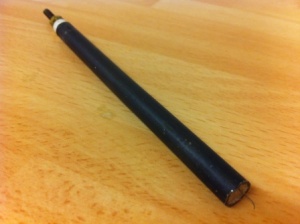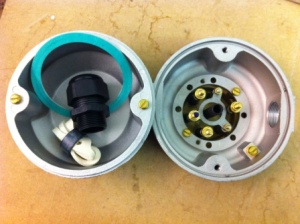An immersion heater is, simply put, a number of elements, usually 3, elements, a screwplug and a IP rated terminal box to protect the connections.



And, in the best Blue Peter traditions, here’s
one we made earlier…

You then screw the heater into the tank. Usually via a weld boss.

Mild steel tanks require mild steel weld bosses, and likewise, stainless steel tanks require horribly priced stainless steel weld bosses. Brass bosses are for copper tanks, alledgedly.
BSP SCrewplug Sizes Simple Version.
Simply put, I am hoping you measure the screwplug of your dead heater at 65mm.
Or alternatively, the hole in your vessel at 63mm.
Either way, this measurement is best acheived with a Vernier Gauge if you have one handy. A tape measure and a steady hand will have to suffice if not. As a backup, a bit of string or cotton, wrapped around the circumference of the dead heater screwplug, then measured on the tape measure, should give you a good approximation.
The safest, 100% way to check your screwplug size is to wander casually into a Plumbase, Screwfix, or the like, and ask for a nut of your guesstimated size, then screw it on to the heater. This avoids the unlikely, but still possible accurence that you are the possessor of a “Bastard Size” which may have a different thread pitch, number of threads per inch, etc.
Further detailed article HERE.
Wiki detailed table HERE.
Diving Deeper – What is a Heating Element?
Again, a video for visual learners.
Further detail available HERE on our Blog, ElementsofHeating.
The top end is the terminal, sometimes a spade connection, but more usually a thread, washer and bolt combination, geared at holding the electrical connection, ie, incoming wire, in place.
Below the nuts is a white plastic plug which serves as a seal against ingress of moisture and also to hold all of the important bits inside in the middle of the tube, away from the sheathing.
The sheathing material is the outer housing, the solid casing, usually made of a metal, in this case Incoloy 800, a stainless steel variant. This serves to encase and protect the important bits, protecting them from whatever is being heated, ie, oils, chemicals, etc.
The white compacted powder inside the tube is magnesium oxide powder, which serves as an insulator against electrical leakage, but as a conductor of the heat generated by that electrical current. It serves to hold the filament wire centrally within the tube so that contact with the sheathing material is all but impossible.
What is an immersion heater? – Tiny Wire
Finally, the tiny wire seen protruding at the bottom of the picture is the filament wire which creates the heat in the core of the element. Usually Nickel Chromium, this converts electricirty very efficiently into heat, with only a little wastage as light, as with the filament of an old light bulb. Whilst it is straight in the picture above (due to being hacksawed), under normal circumstances it would be coiled centrally in the magnesium oxide, as shown below, in this very cool x-ray.
Dead Length?
The picture above also helps to explain the terms cold end, cold section, dead length, etc. The bit before the wiggly filament, that looks a bit like a hose pipe, is the other end of the terminal pin, the nuts & washers electrical connection as described above. Usually mild steel, this section is not going to create a great deal, if any heat, and so this is termed the cold section. All elements have two terminals, one at either end, to complete an electrical circuit, and both ends will have a cold section of 2 – 6″ dependent on the application.
This length would have to be subtracted from the element length when calculating watts density, ie, a 48″ 1000W element with 6″ colds has only 36″ active length (48″ – 6″ – 6″ = 36″), so the watts density of this element is 1000 / 36 = 28w/in².
What is an immersion heater? More useful info on ElementsOfHeating
All of this information & more is available on our blog, ElementsOfHeating where there is a wealth of relevant and useful information. There is an explanation of what a heating element actually is. Also we have a full description and explanation of the component parts of a screwed immersion heater. Furthermore ther is my best punt at explaining the joys of watt density, and it’s crucial importance when choosing the most appropriate immersion heater for water, oil, and breweries. Also available is an informational entry about the process we go through when designing immersion heaters generally.
If you now realise that what you are in fact searching for is a Heating Element, as opposed to an Immersion Heater, you have two options. You can stay on this website, research Heating Elements, find what you need, & then call Jamie on 01827 215684.
Or you can go to our sister site, HeatingElements.co.uk where you will find additional information, and you are able to buy online, should you wish to avoid a long telephone conversation with Jamie, about Life, the Universe & Everything. Or perhaps you love banks & their 2% charges. I don’t. So please call Jamie on 01827 215684.
Informational content provided by Jamie at ImmersionHeaters.UK or 01827 215684.
